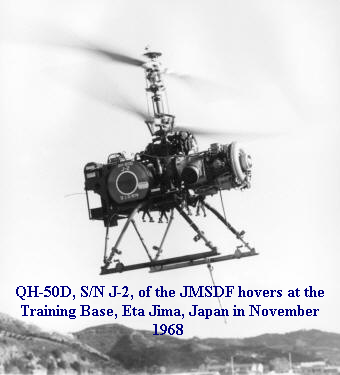
 With the virtual destruction of the Japanese Navy after World War II and the
anti-military attitude that followed in Japan, the United States needed the
Japanese to be able to at least maintain their own coastal waters associated
with maintaining aids to navigation, pollution control, search and rescue as
well as clearing the tens of thousands of mines the U.S. Navy had placed in
Japanese waters during the war. This need created the Maritime Safety Agency
(MSA) on 1 May 1948 as a division of the Ministry of Transportation. The ships
the MSA had to use were basically 155 small patrol ships left over from the
devastated Imperial Japanese Navy (IJN) along with 53 minesweepers, 20
hydrographic ships and 52 lighthouse tenders. With the virtual destruction of the Japanese Navy after World War II and the
anti-military attitude that followed in Japan, the United States needed the
Japanese to be able to at least maintain their own coastal waters associated
with maintaining aids to navigation, pollution control, search and rescue as
well as clearing the tens of thousands of mines the U.S. Navy had placed in
Japanese waters during the war. This need created the Maritime Safety Agency
(MSA) on 1 May 1948 as a division of the Ministry of Transportation. The ships
the MSA had to use were basically 155 small patrol ships left over from the
devastated Imperial Japanese Navy (IJN) along with 53 minesweepers, 20
hydrographic ships and 52 lighthouse tenders.
As time went on and area tensions increased from North Korea,
China and the Soviet Union, it became clear that Japan needed more than a Coast
Guard to guard its waters. In 1952, a Coastal Safety Force was created within
the MSA but by the end of 1954 that Coastal force was separated from the MSA and
recreated as the
Japanese Maritime Self Defense Force (JMSDF) which became the
new Japanese Coastal force. The JMSDF had its beginning by the acquisition of former U.S.
Naval vessels such as GLEAVES and
FLETCHER class of Destroyers. This was done
because Japanese Ship building laid in ruin from the strategic bombing it had
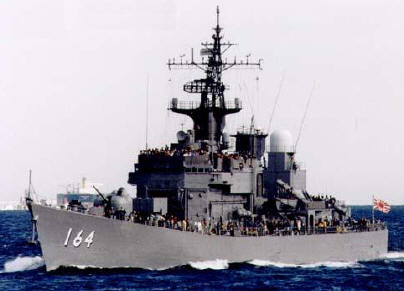 suffered during WWII. However, beginning in 1960, the Japanese began to build
their own warships based on foreign technology such as using American weapons
and sensor systems. These Warships were very conservative in design and built as
defensive units. suffered during WWII. However, beginning in 1960, the Japanese began to build
their own warships based on foreign technology such as using American weapons
and sensor systems. These Warships were very conservative in design and built as
defensive units.
The Philosophy that drove the design criteria for the new
JMSDF was heavily influenced by their experiences in World War II.
When
asked to give credit to the instruments and machines that had allowed the
United States to win the war in the Pacific, Admiral William "Bull" Halsey
answered, "Submarines first, radars second, planes third and bulldozers fourth."
This evaluation was not lost on the Japanese as they heavily loaded their new
Coastal force with Anti-Submarine Warfare (ASW) weaponry with an obsession towards that goal
that to this day is unmatched.
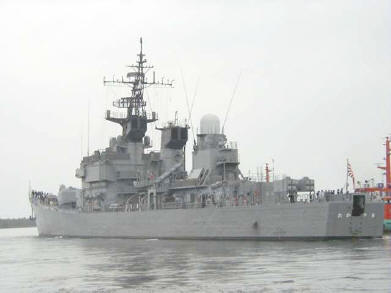 In 1967, at the Ishikawajima Harima Shipyard,
this obsession of loading their largest destroyer "to the teeth" was seen in the
TAKATSUKI class destroyer (seen at left). While only
3100 tons standard, the TAKATSUKI class
destroyer had the same weaponry that U.S. Destroyers of double the tonnage would
contain including 2-aircraft DASH capability, ASROC with reload capability,
Weapon Alpha as well as two MK-32 Triple Torpedo tubes and one four-tube BOFORS
ASW launcher. Yet, while this ASW obsession-philosophy even reached down to
smaller Japanese torpedo boats which were equipped with dipping sonars,
sonobuoys as well as ASW torpedoes, the threat from the air was relatively
ignored using only obsolete 3-inch/50 caliber guns. This was due to the
overriding mission being to keep the sea-lanes clear of submarines as Japan
imported almost all of the raw materials its economy required and still does.
Even though the new Japanese Maritime Self-Defense Force had become by
1970, the 10th most powerful Navy in the World, it was never discussed outside
inner circles until 1980 when public opinion began to change in light of
exterior threats to Japan as the U.S. Navy was increasingly stretched between
protecting Japan and responding to threats to U.S. national security related to
Taiwan and the middle east. In 1967, at the Ishikawajima Harima Shipyard,
this obsession of loading their largest destroyer "to the teeth" was seen in the
TAKATSUKI class destroyer (seen at left). While only
3100 tons standard, the TAKATSUKI class
destroyer had the same weaponry that U.S. Destroyers of double the tonnage would
contain including 2-aircraft DASH capability, ASROC with reload capability,
Weapon Alpha as well as two MK-32 Triple Torpedo tubes and one four-tube BOFORS
ASW launcher. Yet, while this ASW obsession-philosophy even reached down to
smaller Japanese torpedo boats which were equipped with dipping sonars,
sonobuoys as well as ASW torpedoes, the threat from the air was relatively
ignored using only obsolete 3-inch/50 caliber guns. This was due to the
overriding mission being to keep the sea-lanes clear of submarines as Japan
imported almost all of the raw materials its economy required and still does.
Even though the new Japanese Maritime Self-Defense Force had become by
1970, the 10th most powerful Navy in the World, it was never discussed outside
inner circles until 1980 when public opinion began to change in light of
exterior threats to Japan as the U.S. Navy was increasingly stretched between
protecting Japan and responding to threats to U.S. national security related to
Taiwan and the middle east.
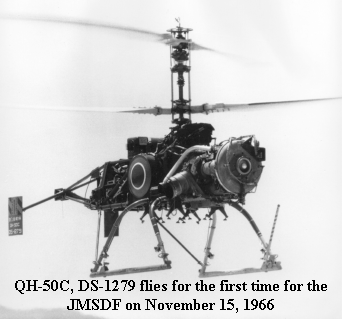 THE JMSDF AND DASH THE JMSDF AND DASH
 The JMSDF stands out as having made the DASH Weapon
System work to a success rate the U.S.
Navy simply did not attain. By June 1, 1970 the U.S. Navy stated that of the original 746 QH-50C/D drone
helicopters originally built for the U.S. DASH program, 411 aircraft had been lost. The
JMSDF, however, which announced their DASH program launch in 1963, attained a success rate unheard of in the U.S. Navy. The JMSDF stands out as having made the DASH Weapon
System work to a success rate the U.S.
Navy simply did not attain. By June 1, 1970 the U.S. Navy stated that of the original 746 QH-50C/D drone
helicopters originally built for the U.S. DASH program, 411 aircraft had been lost. The
JMSDF, however, which announced their DASH program launch in 1963, attained a success rate unheard of in the U.S. Navy.
When
the U.S. Navy's DASH program was in full operation, the U.S. Navy loaned the Japanese
Maritime Self-Defense Force (JMSDF) three QH-50C drones under the Military
Assistance Program (MAP) and sold the JMSDF a
single D model aircraft in 1965 to see if DASH
could bolster the JMSDF's ASW capabilities. The C model serial numbers were DS-1278, DS-1279 and DS-1280.
The D model was DS-1494.
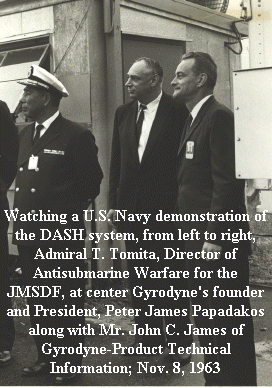 With a dual torpedo delivery capability in any weather, a 45 mile
delivery range and the close proximity to Soviet Union (USSR) Naval Bases, the
Japanese were very interested in the DASH concept. After testing, the JMSDF
purchased 16 additional aircraft from Gyrodyne in 1967 (All D models) through
the Nissho-Iwai Trading company, with the final delivery in September 1971. They
were serial numbers J-1 through J-16. With a dual torpedo delivery capability in any weather, a 45 mile
delivery range and the close proximity to Soviet Union (USSR) Naval Bases, the
Japanese were very interested in the DASH concept. After testing, the JMSDF
purchased 16 additional aircraft from Gyrodyne in 1967 (All D models) through
the Nissho-Iwai Trading company, with the final delivery in September 1971. They
were serial numbers J-1 through J-16.
Above
left,
QH-50C, number DS-1279, flies for the first time on
November 15, 1966 from the training base at Eta Jima, Japan; the JMSDF training
facility. By March 31 1971,The JMSDF had flown over 1,440 hours. By September of
1971, SEVEN Japanese Destroyers were flying DASH, with a
success rate of 360 hours mean time before failure (MTBF) which was twice the
U.S. Navy's over-all record. Yet this success was not by accident.
The Japanese success with
their DASH program can be seen in the different manner in which the JMSDF
managed their DASH program. The primary difference was the length of time the JMSDF personnel
stayed with the program. Capt. Robert H. Beyer USNR (ret), Gyrodyne's then
Director for International Operations, who worked with the JMSDF for
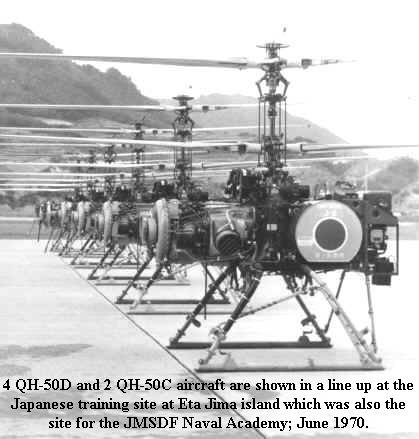 over six
and one half years, stated that personal whom he knew in 1966 were still with
the program in 1971. Compare this to the U.S. Navy it was not at all unusual to
have a DASH Officer "come and go" through a specific DASH command within six
months. Further, there were instances on U.S. Naval destroyers where the senior
enlisted man in a DASH group was a 3rd class Petty Officer. over six
and one half years, stated that personal whom he knew in 1966 were still with
the program in 1971. Compare this to the U.S. Navy it was not at all unusual to
have a DASH Officer "come and go" through a specific DASH command within six
months. Further, there were instances on U.S. Naval destroyers where the senior
enlisted man in a DASH group was a 3rd class Petty Officer.
The Japanese treated their DASH operation
with much more prestige as the commanding Officer of the Training School was a
full Captain with full commanders as maintenance and training officers.
As far as assignments on Ship, further
distinctions were seen. In the U.S. Navy program, the DASH group was comprised
of one officer and four enlisted men. Of the 4 enlisted men, at least two in the
billet had aviation ratings yet all in the billet were assigned regular shipboard
duties with their DASH assignment considered secondary or collateral as the
needs of the ship determined priority.
On a JMSDF
destroyer, DASH assignments were considered primary duty with other shipboard
assignments considered collateral. Further, Japanese technicians would meticulously wash and wax all drones before
returning them to their hangars. Capt. Beyer stated that, "When you looked at a
Japanese bird, it looked like it just came from the factory -even though it
might be three years old. By contrast, I've been aboard some U.S. Destroyers
whose birds had corrosion like icicles!". In fact, the U.S. Navy's CRUDESPAC (Commander,
cruisers, destroyers-pacific fleet) instituted a program to remove DASH drones
and have them decontaminated by a Japanese contractor (Shinmewa Industries).
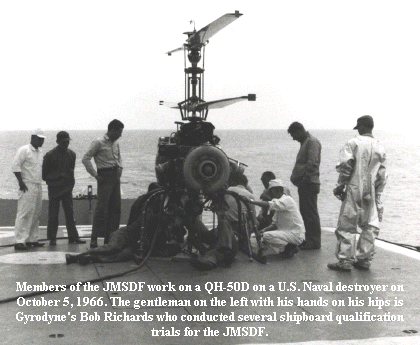 Flight time of the DASH system and DASH
controller flight proficiency also appeared to be a major issue of why
the two separate Navy's had differing results of success. When the U.S. Navy's
DASH program was in full operation, U.S. Destroyer Commanders were required to
fly their DASH system at a minimum of 4 hours monthly. Some Skippers, as log
book evidence shows, would try to fly the aircraft at the end of one month and
then the next day, on the beginning of the following month to accomplish all
their flight requirements and then park the aircraft away in their hangars for
fear of losing an aircraft which might result in a black-mark upon their service
records. Further, when U.S. Naval destroyers were on plane guard duty for
carrier battle groups, the DASH aircraft were not flown as Carrier pilots did
not want drones flying amongst them. Later, when the camera-spotting QH-50
SNOOPY variant was introduced, Destroyers not on plane guard duty were able to
fly without these restrictions. All of this down-time, however, resulted in
"cold" drone Controllers not having sufficient time to stay current in flight
operations where losses were then high. By contrast, the JMSDF flew their DASH
program daily. By doing this, the crews were very current and resulted in only
two losses by October 1971, which were equipment related and not operator error.
Flight time of the DASH system and DASH
controller flight proficiency also appeared to be a major issue of why
the two separate Navy's had differing results of success. When the U.S. Navy's
DASH program was in full operation, U.S. Destroyer Commanders were required to
fly their DASH system at a minimum of 4 hours monthly. Some Skippers, as log
book evidence shows, would try to fly the aircraft at the end of one month and
then the next day, on the beginning of the following month to accomplish all
their flight requirements and then park the aircraft away in their hangars for
fear of losing an aircraft which might result in a black-mark upon their service
records. Further, when U.S. Naval destroyers were on plane guard duty for
carrier battle groups, the DASH aircraft were not flown as Carrier pilots did
not want drones flying amongst them. Later, when the camera-spotting QH-50
SNOOPY variant was introduced, Destroyers not on plane guard duty were able to
fly without these restrictions. All of this down-time, however, resulted in
"cold" drone Controllers not having sufficient time to stay current in flight
operations where losses were then high. By contrast, the JMSDF flew their DASH
program daily. By doing this, the crews were very current and resulted in only
two losses by October 1971, which were equipment related and not operator error.
In the defense to the U.S.
Navy, it can be said that the height of the U.S. Navy's DASH program
corresponded to the peak in the war in Vietnam where skilled and experienced
DASH personnel were being transferred off Destroyers and onto billets on
Carriers fighting the air war. Further, while the JMSDF was a coastal defense
force with the resulting short-logistic supply chain, the U.S. Navy was a "Blue
Water Navy" with responsibilities all over the world resulting in a very long
logistics supply chain. U.S. Navy destroyers were deployed for six months or
more and had to work with the parts and personnel they had. Essentially, when
the JMSDF had a parts or component problem with their DASH aircraft, they were
able to have it fixed quicker because they were so close to port!
However, it should also be stated, that for
the Japanese, the DASH equipped Destroyers were the equivalent to "their
aircraft carriers"; those JMSDF DASH destroyers received the best personnel and had
the highest priority in their Navy.
The JMSDF-DASH Officer corps were puzzled
over the U.S. Navy's cancellation of DASH in Nov. 1969 because they judged their
own program to be a great success. However, despite that great success, the
JMSDF was forced to close down their DASH program because of the simple
economics of keeping their DASH program active with the U.S. Navy canceling
their. By 1977 the JMSDF removed
DASH from their ships and changed the missions of those
ships.
At that time,
the Japanese had lost only three reported aircraft. What happened to the
remaining seventeen QH-50s is not known.
Here we present the two classes of DASH equipped ships of the JMSDF. While the Japanese did use the same weapons of the U.S. Navy,
they increased their complement capacity of DASH aircraft per ship to three on the
TAKATSUKI class while maximum
aircraft in a U.S.-FRAM Ship hangar numbered only two. Yet, the TAKATSUKI never
operated with three since the JMSDF ships operated locally, they used the
training site at Eta Jima for intermediate level maintenance; items requiring
depot level were sent to Gyrodyne via a Nissho contract.
  TAKATSUKI CLASS DESTROYERS (DD) TAKATSUKI CLASS DESTROYERS (DD)
|
Name of Ship
|
Hull No.
|
Builder
|
Launched
|
Status
as of 2003
|
TAKATSUKI
|
164
|
Ishikawajima, Harima
|
7 Jan. 1966
|
Operating from the port of Maizuru, she is part of the 24th Escort
Flotilla
|
KIKUZUKI
|
165
|
Mitsubishi, Nagasaki
|
25 Mar 1967
|
Operating from the port of Maizuru, she is part of the 24th Escort
Flotilla
|
MOCHIZUKI
|
166
|
Ishikawajima, Harima
|
15 Mar 1968
|
Stricken
19 Mar 1999
|
NAGATSUKI
|
167
|
Mitsubishi, Nagasaki
|
19 Mar 1969
|
Stricken
01 April 1996
|
  TAKATSUKI CLASS DESTROYERS (DD)
SPECIFICATIONS TAKATSUKI CLASS DESTROYERS (DD)
SPECIFICATIONS
|
Displacement:
|
3,100 tons Standard, 4,500
tons FULL LOAD
|
Dimensions:
|
446' 2" long x 43' 11" beam x 14' 5" maximum draft
|
Guns:
|
1 qty, 5-inch/54 Caliber Mark 42 Single dual purpose Gun Mounts; rapid
fire, radar controlled on TAKATSUKI and KIKUZUKI
2 qty, 5-inch/54 Caliber Mark 42 Single dual purpose Gun Mounts; rapid
fire, radar controlled on MOCHIZUKI and NAGATSUKI
The 5-inch guns were controlled by the GE Mk-56 GFCS with Mk-35 radar except NAGATSUKI
which had the Mark 56-2.
In 1985, a single 20-mm Phalanx (Mark 15) Gatling CIWS was installed
on all ships replacing aft 5" gun mount
|
ASW Weapons:
|
Three qty, DASH Helicopters (removed in 1977)
Two triple 324-mm (Type 68)/MK 32 torpedo tubes for Mk 46 torpedoes
One 375-mm BOFORS (Type 71) trainable 4-barrel ASW mortar
One Mark 112 ASROC ASW rocket launcher
|
Electronics:
|
RADAR
Air Search Radar: Melco OPS-11B-Y
Surface Search Radar: JRC OPS-17
SONAR
One SQS-23 System.
One U.S. AN/SQS-35(j) Variable Depth Sonar (medium frequency) but not
installed in DD 166.
One Sangamo OQS-3 hull-mounted medium frequency in DD 166 and 167.
|
Boilers
|
Two Mitsubishi/Westinghouse or Mitsubishi/GE boilers
|
Machinery
|
2-shaft Mitsubishi geared impulse reaction steam turbines each coupled to a
Mitsubishi locked-train double reduction gears.
2 Shafts, 60,000 SHP = 32
Knots
|
Radius:
|
At 4,500 tons full load, maximum speed is 32
knots with endurance of 7,000 nautical miles at 20 knots
|
Complement:
|
Allowance: 270
|
The FATE of the TAKATSUKI class of Destroyers.
As for the four TAKATSUKI class destroyers, with DASH now
removed, the Japanese faced the same modernization question the U.S. Navy faced:
What do you do for ships reaching their retirement life?
The JMSDF decided to modernize
TAKATSUKI in
1984-1985 by replacing the DASH Hangar and Variable depth Sonar with the
Anti-Ship Harpoon (2 - quad Harpoon (RGM-84C) SSM launchers) and Anti-Air/Ship
Sea Sparrow missile systems (1 - Mk 29 SAM launcher-16 missiles). They also
installed the EDO-NEC OQR-1 (AN/SQR-18A) Sonar Tactical Towed Array System (TACTAS), which is
a long cable full of microphones that is towed about a mile behind the ship
which is used to detect noise signatures of a submarine. During 1985 to 1986,
KIKUZUKI was also refitted in this manner but then received the MK 15 Phalanx
Close-In Weapons System (CIWS) in 1989. During the refit of both ships the
Electronic Counter Measures systems were also updated to include a Fujitsu OLT-3 jammer
and two SRBOC Mark 36 chaff/decoy rocket launchers.
With TAKATSUKI and KIKUZUKI modernized, their
careers continue with both vessels being used as training ships operating with
the 24th Escort Flotilla. The unconverted MOCHIZUKI and NAGATSUKI remained in
their DASH configuration until being stricken March 19, 1999 and April 1, 1996,
respectfully.
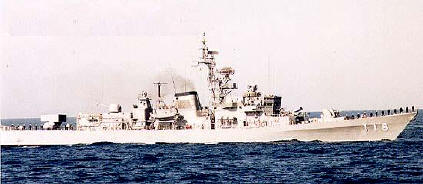 Closely following the YAMAGUMO class destroyer in design, the MINEGUMO class
were 1000 tons lighter than their fellow TAKATSUKI class DASH ships and were
diesel powered vs. steam. They were new constructed ships and built with DASH
from the keel-up based on the same ASW principles that drove the design of the
TAKATSUKI class DD. Like the other JMSDF destroyers, the MINEGUMO class were
heavily weaponized for Anti-submarine warfare. However, given the time frame of
being completed from 1968-1970, the Three vessels of this class only had DASH
for 9 years at the most and thus required "modernization" after DASH left ship
to maintain the ASW mission capability, even though none of these systems came
close to DASH's range.
Closely following the YAMAGUMO class destroyer in design, the MINEGUMO class
were 1000 tons lighter than their fellow TAKATSUKI class DASH ships and were
diesel powered vs. steam. They were new constructed ships and built with DASH
from the keel-up based on the same ASW principles that drove the design of the
TAKATSUKI class DD. Like the other JMSDF destroyers, the MINEGUMO class were
heavily weaponized for Anti-submarine warfare. However, given the time frame of
being completed from 1968-1970, the Three vessels of this class only had DASH
for 9 years at the most and thus required "modernization" after DASH left ship
to maintain the ASW mission capability, even though none of these systems came
close to DASH's range.
  MINEGUMO CLASS DESTROYERS (DDK) MINEGUMO CLASS DESTROYERS (DDK)
|
Name of Ship
|
Hull No.
|
Builder
|
Launched
|
Status
as of 2003
|
MINEGUMO
|
DDK 116 /
TV 3609
|
Mitsui, Tamano
|
16 Dec.1967
|
Although Modernized in 1995, she was stricken in 1999
|
NATSUGUMO
|
DDK 117 /
TV 3510
|
Uraga, Yokosuka
|
25 July 1968
|
Although Modernized in 1995, she was stricken in 1999
|
MURAKUMO
|
DDK 118 /
TV 3511
|
Maizuru, H.I.
|
15 Nov. 1969
|
Modernized in 1998, she was stricken in 2000
|
  MINEGUMO CLASS DESTROYERS (DDK)
SPECIFICATIONS MINEGUMO CLASS DESTROYERS (DDK)
SPECIFICATIONS
|
Displacement:
|
2,100 tons Standard, 2,750
tons FULL LOAD
|
Dimensions:
|
376' 11" long x 38' 9" beam x 12' 6" maximum draft
|
Guns:
|
4 qty, 3-inch/50 Caliber Mark 33 in two Twin Gun Mounts; MURAKUMO only
had 2.
NOTE: MINEGUMO's aft 3" turret eventually replaced by a single
FMC/OTO Melara 76mm/62 cal Mk 75 compact gun to test this new system.
|
ASW Weapons:
|
Two qty, DASH Helicopters (removed in 1977)
Two triple 324-mm (Type 68)/MK 32 torpedo tubes for Mk 46 torpedoes
One 375-mm BOFORS (Type 71) trainable 4-barrel ASW mortar
NOTE:
One Honeywell Mark 112 ASROC ASW rocket launcher (MK-46 torpedoes)
installed on DASH deck after DASH was removed in 1978.
|
Electronics:
|
RADAR
Air Search Radar: Melco OPS-11B-Y
Surface Search Radar: JRC OPS-17
SPG-34 Gun-Control Radar
SONAR
One Sangamo OQS-3 hull-mounted medium frequency.
NOTE: MURAKUMO also had one U.S. AN/SQS-35(j) Variable Depth Sonar (medium
frequency)
|
Machinery
|
2-shafts, 6 Mitsubishi IZUEV 30/40 DIESELS, 26,500 bhp = 27 KNOTS.
|
Radius:
|
At 2,750 tons full load, maximum speed is 27
knots with endurance of 7,000 nautical miles at 20 knots
|
Complement:
|
Allowance: 205
|
The FATE of the MINEGUMO class of Destroyers.
While the MINEGUMO class of Destroyer differed between
its similar YAMAGUMO class ship in that YAMAGUMO placed its ASROC launcher
between two small smokestacks, the MINEGUMO's single stack for all six of its
diesel engines provided no other placement of the ASROC equipment, to keep the
MINEGUMO's ASW capabilities in pace with the JMSDF, than the aft flight deck
which prevented any further use of the expanding mission of the ASW helicopter,
which in Japan was being tested on the HARUNA class helicopter destroyers which
the U.S. Navy was now heavily into development with the LAMPS program.
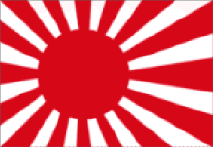 This
loss of any future expanded role in ASW war fighting caused all the MINEGUMO
class destroyers to be rated as training vessels (TV) with MINEGUMO being
reclassified on 01 August 1995 as TV-3509. MURAKUMO had been the Flag-ship of
the JMSDF but after 16 March 1998, MURAKUMO was classified as a Training Vessel
(TV-3511) after which it received a student auditorium and accommodation
quarters for women. NATSUGUMO, while reclassified as TV-3510, was in such poor
hull shape, that it had to be stricken in 1999. Following that, the other two
MINEGUMO class were retired in 2000. This
loss of any future expanded role in ASW war fighting caused all the MINEGUMO
class destroyers to be rated as training vessels (TV) with MINEGUMO being
reclassified on 01 August 1995 as TV-3509. MURAKUMO had been the Flag-ship of
the JMSDF but after 16 March 1998, MURAKUMO was classified as a Training Vessel
(TV-3511) after which it received a student auditorium and accommodation
quarters for women. NATSUGUMO, while reclassified as TV-3510, was in such poor
hull shape, that it had to be stricken in 1999. Following that, the other two
MINEGUMO class were retired in 2000.
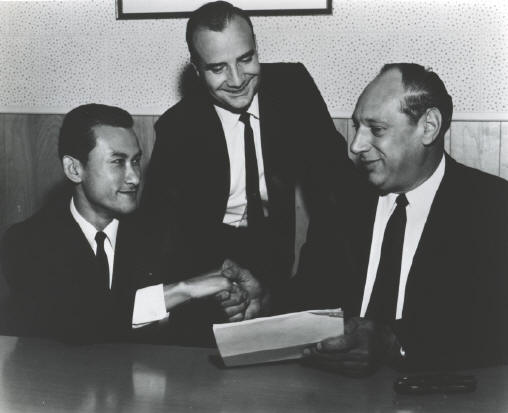
The Deal gets Signed! Initially valued at $
1,500,000 in July 1966, the first export sales order by the Nissho
Company, Ltd., on behalf of the JMSDF, is executed by, from left to right, Mr.
K. Uenoyama of The Nissho Company, Ltd.,, Mr. A. McCarthy, Gyrodyne Export Sales
and Mr. Peter J. Papadakos, Gyrodyne founder and President. Nissho Company would
act as sales representative as Gyrodyne sought to expand the market for the
QH-50D. This initial purchase included the initial order of QH-50D's, special
support equipment, field and customer training services as well as spare parts.
Deliveries were slated to begin in early 1967.

Many thanks to Capt. Robert H. Beyer
USNR (ret) whose experience with working with the JMSDF for 6 1/2 years on
behalf of Gyrodyne led to the insightful information contained on this page.
Many Thanks!

  

|







 Closely following the YAMAGUMO class destroyer in design, the MINEGUMO class
were 1000 tons lighter than their fellow TAKATSUKI class DASH ships and were
diesel powered vs. steam. They were new constructed ships and built with DASH
from the keel-up based on the same ASW principles that drove the design of the
TAKATSUKI class DD. Like the other JMSDF destroyers, the MINEGUMO class were
heavily weaponized for Anti-submarine warfare. However, given the time frame of
being completed from 1968-1970, the Three vessels of this class only had DASH
for 9 years at the most and thus required "modernization" after DASH left ship
to maintain the ASW mission capability, even though none of these systems came
close to DASH's range.
Closely following the YAMAGUMO class destroyer in design, the MINEGUMO class
were 1000 tons lighter than their fellow TAKATSUKI class DASH ships and were
diesel powered vs. steam. They were new constructed ships and built with DASH
from the keel-up based on the same ASW principles that drove the design of the
TAKATSUKI class DD. Like the other JMSDF destroyers, the MINEGUMO class were
heavily weaponized for Anti-submarine warfare. However, given the time frame of
being completed from 1968-1970, the Three vessels of this class only had DASH
for 9 years at the most and thus required "modernization" after DASH left ship
to maintain the ASW mission capability, even though none of these systems came
close to DASH's range.


 This
loss of any future expanded role in ASW war fighting caused all the MINEGUMO
class destroyers to be rated as training vessels (TV) with MINEGUMO being
reclassified on 01 August 1995 as TV-3509. MURAKUMO had been the Flag-ship of
the JMSDF but after 16 March 1998, MURAKUMO was classified as a Training Vessel
(TV-3511) after which it received a student auditorium and accommodation
quarters for women. NATSUGUMO, while reclassified as TV-3510, was in such poor
hull shape, that it had to be stricken in 1999. Following that, the other two
MINEGUMO class were retired in 2000.
This
loss of any future expanded role in ASW war fighting caused all the MINEGUMO
class destroyers to be rated as training vessels (TV) with MINEGUMO being
reclassified on 01 August 1995 as TV-3509. MURAKUMO had been the Flag-ship of
the JMSDF but after 16 March 1998, MURAKUMO was classified as a Training Vessel
(TV-3511) after which it received a student auditorium and accommodation
quarters for women. NATSUGUMO, while reclassified as TV-3510, was in such poor
hull shape, that it had to be stricken in 1999. Following that, the other two
MINEGUMO class were retired in 2000.




![]()
![]()